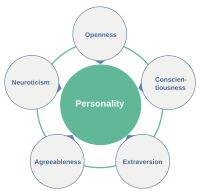
Photo from wikipedia
Abstract Objective: There are considerable differences in how eating disorder (ED) patients respond to treatment. This study aimed to identify change trajectories of mental health during treatment. Method: Longitudinal data… Click to show full abstract
Abstract Objective: There are considerable differences in how eating disorder (ED) patients respond to treatment. This study aimed to identify change trajectories of mental health during treatment. Method: Longitudinal data of 442 patients was used with five time points during a year of outpatient treatment. ED psychopathology and well-being were used as primary measures. A series of latent growth mixture models were applied to model trajectories of change. Results: Three latent classes were found for ED psychopathology and well-being. For ED psychopathology, a high baseline severity and slow recovery class (55.9% of the patients), a high baseline severity followed by a substantial recovery class (19.9%) and a moderate baseline severity and no significant recovery class (24.2%) were found. For well-being, a low baseline followed by a slow growth class (44.6%), a low baseline and substantial growth class (9.5%) and a moderate and stable well-being class (45.9%) was found. General psychopathology, early symptom change, hope for recovery, intrinsic motivation and the ED type were predictive of class membership in either ED psychopathology or well-being. Conclusions: This study shows variability in ED psychopathology and well-being change trajectories, modelled in meaningful latent recovery classes. These results may have clinical implications, such as adjusting patients’ treatment based on change trajectories.
Journal Title: Psychotherapy Research
Year Published: 2022
Link to full text (if available)
Share on Social Media: Sign Up to like & get
recommendations!